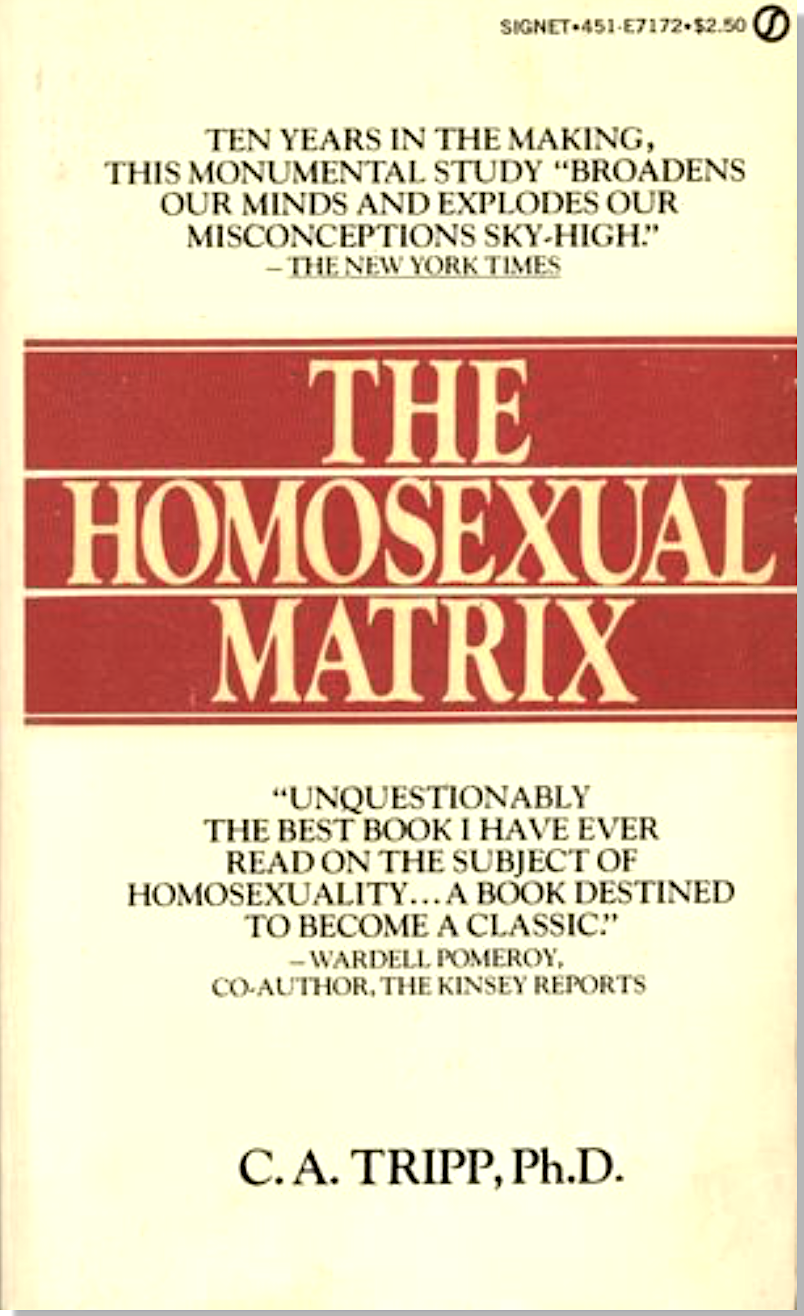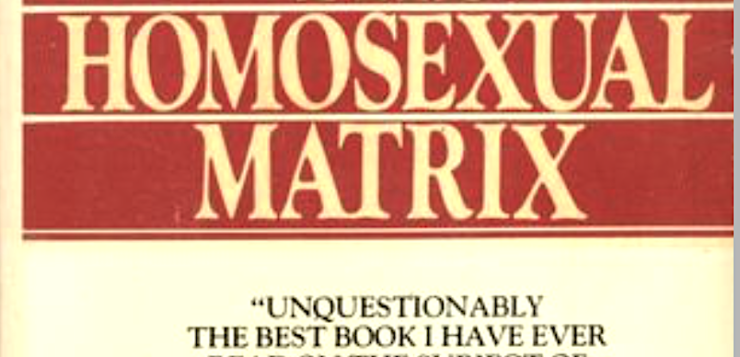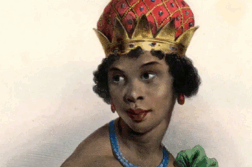Editor’s Note: In the last issue, Part 1 of this essay discussed the collaboration of renowned sex researcher Alfred Kinsey and the budding sexologist C.A. Tripp, starting in the late 1940s. Tripp was openly gay and went on to publish, in 1975, a book titled The Homosexual Matrix, which became a sensation of the Gay Liberation era but was also controversial for some of the positions it advanced. Tempers flared among LGBT intellectuals, so the author of this piece decided to invite about fifteen academics to meet with Tripp in a spacious New York City apartment. Part 2 picks up with an accounting of these discussions.

THE FIRST GATHERING to discuss The Homosexual Matrix, which was held on February 2, 1976, was a good deal less fraught than my confrontation with Arno Karlen, though hardly a love fest. Over a five-hour period, most of the hot-button topics relating to sexuality came up for discussion, sometimes in heated exchanges. I found that I liked Tripp the man better than I had expected to, since most of the advance reports had described him as arrogant, closed-minded, and “difficult.” The peremptory note did unmistakably sound now and then, but so did his warmth and charm—though I didn’t entirely trust the charm, which seemed to be in the service of evasion, at which Tripp proved exceedingly skillful.
The group of invitees was bright, well-informed, and tenacious in their criticism (a match for Tripp’s tenacity in ignoring it). None of the objections raised to his views seemed to make a dent, though I thought much of the criticism was telling. I myself pressed him on the lack of supporting evidence for some of his claims, even while acknowledging that the imaginative insights I most admired about the book were in pleasant contrast to the academy’s notion of what constituted “true” scholarship. “For God’s sakes, Duberman,” Tripp later told me privately. “Kinsey didn’t base his conclusions on those umpteen thousand interviews, but on his direct observations watching sex—including watching me and a long line of lovers!” Maybe so, I rather stumblingly replied—Tripp, after all, had worked directly with Kinsey—but the book’s paucity of citations made it difficult to defend his work to literal-minded scholars.
To my mind, the most serious objection raised that first afternoon concerned Tripp’s claim that sex is “focal” for males, but innately “peripheral” for females. He offered as confirmation the many consultations he’d had with female researchers about his conclusions. Annoyed at his presumptive tone, I was among those who pointed out that “we all choose our consultants, and consciously or not go to experts who we know or sense hold views comparable to our own.” The anthropologist Edgar Gregersen (who would later write Sexual Practices) added that the anthropological literature did not confirm Tripp’s sweeping statements on female sexuality: Edgar gave Mangaia as an example. It was a culture where all women have orgasms—because they demand them, not because of male desire, attentiveness, or proficiency.
Tripp was a good deal more persuasive—this was 1976, before the advent of the trans movement—in his insistence that a majority of “transvestites” were not homosexual (and vice versa). When he further trashed aversion therapy as “a joke”—and a harmful one—he found no disagreement. He also made a strong (if perhaps too encompassing) case that sadomasochistic sex was not intrinsically destructive, but instead a carefully calibrated case of “resistance.” And resistance, he claimed—that is, some kind of barrier, some sort of impediment to easy access, a degree of tension, distance, alienation—was an essential element in forming and maintaining erotic attraction. In long-term relationships, he argued, the ongoing presence of “resistance” was essential to the continuation of sexual arousal. Individuals who equate arousal with roses and romance are merely acting out the nonsense of our adolescent culture. Therapists who seek “harmony”—an absence of stress and combat—are in the foolish business of leading their clients down a path that ends either in celibacy or outside affairs.
Intriguingly, Tripp also told us that at the last minute he’d pulled his chapter on aging from the book as “too far out.” What he’d concluded, he said, was that homosexuals age better than heterosexuals—despite the stereotype that, devoid of family ties, they fall into despair after youth fades. The excessive focus in heterosexual American families on the children, he went on, is accompanied by the illusion—almost always disappointed—that the parents’ “sacrifices for the kids” will produce grateful offspring attentive as adults to the needs of their aging parents. In contrast, Tripp argued, the emphasis on youthfulness in gay culture forces homosexuals at a much earlier point to deal with their fading attractiveness—and to form strong bonds of friendship.
In direct contradiction to the theories of Irving Bieber and Charles Socarides, the psychiatrists responsible for establishing the binding mother/absent father theory that had long dominated the profession’s understanding of the origins of homosexuality, Tripp insisted that anthropology proves that societies in which homosexuality flourishes are those with strong father-son bonds—thus maximizing the opportunity to eroticize male attributes. Yet Tripp also claimed that in cultures where physical bonding between males was commonplace—for example, sleeping intertwined—this practice “short-circuits” genital contact. Put another way, emotional closeness (according to Tripp) leads to genital homosexuality; physical closeness forecloses it. Several of us found the formula too pat, and its claims too sweeping—though Tripp’s speculations were nonetheless intriguing and worth pondering further.
I was less suspicious of Tripp’s own view of causality. He made a persuasive analogy, I thought, with forecasting the weather. With the help of computers and memory banks, he argued, meteorologists have been able to isolate more than 100 variables that influence the weather. Even so, they have great trouble weighing, let alone controlling, the importance of any single variable in explaining a particular outcome—thus the unreliability of weather forecasts and of formulaic explanations for the origins of sexual orientation. What was certain, he went on, was that human sexual behavior was primarily the result of social learning, not biology.
On several other significant issues I found Tripp’s discussion enigmatic or unpersuasive. What he seemed to be saying in regard to male “effeminacy” was that once a homosexual orientation is established, “you go out of production”—that is, you cease to “import” masculine traits. Did that mean, I and others asked, that “effeminate” men become conscious of their orientation at an earlier age than “masculine” homosexuals? Do non-effeminate homosexual men not seek masculine traits in their partners? How does one even define “effeminacy” (or for that matter, “masculinity”)? What specific traits are considered essential to those definitions? And what of the claim that all gay men are effeminate—even those disguised under layers of leather. Tripp’s theory reminded me of 19th-century physics and its belief in “closed energy systems,” though in truth I didn’t understand that either. Similarly, while Tripp explicitly denied Freud’s concept of “innate” bisexuality—the view that one is born psychosexually neutral—he implicitly assumed that some unspecified biological mechanism (hormones? genes?) could interfere with the infant’s sexual readiness for any and all stimuli. But hadn’t he just claimed that social learning and not biology played the primary role in determining sexual orientation?
After the discussion ended and a few of us lingered, Tripp let a bit more of his hair down and entertained us with some salacious tidbits, including Wardell Pomeroy (Kinsey’s co-author) telling him that the “anti-gay” psychiatrist Charles Socarides had “a large homosexual history.” At the end of the afternoon, alone with Tripp, I told him about Arno Karlen’s verbal rampage in my apartment. Tripp replied with a twinkle that Karlen (who in 1976 was a heterosexually married man with children) was himself one of the “106” gay men that Bieber claimed in his “infamous” study to have “cured” through psychotherapy. “Though as is well known,” Tripp added, Bieber “made up much of his data.” He claimed further that in a radio debate with Karlen about his book, Tripp had offered to go over every citation that Karlen found suspect, but Karlen never took him up on the offer.
We held the second of the two Tripp seminars about a month later. In reaction to the position he’d taken at the first meeting that sexuality was “focal” for males but “peripheral” for females, decidedly fewer women showed up. Still, several of Tripp’s pronouncements—he obviously delighted in provocation—met with considerable opposition, though it barely ruffled his composure. Probably the liveliest exchange came over his frequent use of the word “resistance”—not only in regard to sadomasochism (“an extreme form of resistance”) but as a general explanatory tool. “How are you defining ‘resistance’?” someone asked.
“It has many components, including individual isolation, mutual incompatibility, and anger.” With respect to an S/M lifestyle, he insisted that “a tight, prudish religious belief system” was a prerequisite. “Take rimming,” he suggested: “it’s symbolic S/M—and doesn’t escalate.” But the “next step”—for example, whipping—does escalate, though we don’t know why. “Wife-beating,” he added, “is not S/M—it’s hostility.” As for the relationship between social oppression and sadomasochism, Tripp added, “there is a direct correlation between a decrease in social resistance to homosexuality and a rise in aggression (biting, etc.) during sexual encounters, the aggression being one way of maintaining the necessary tension for erotic excitement no longer provided by social disapproval.” That mouthful went unchallenged; it was simply too “packed” to allow for rapid digestion. The closest Tripp came to striking a tentative note regarding S/M was when he declared that “no-one knows why some people need an especially high level of resistance in order to function sexually.”
Some of us wanted a great deal more clarification and tried to get Tripp to further disentangle the various terms he seemed to use interchangeably: Eros, anger, “resistance,” and S/M. Instead, we got enticing tidbits: “Pathology is a foolish concept. A normal base line can be demonstrated in physiology—for example, the eye should be clear, not cloudy—but not in psychology.” “Not even statistically?” someone asked. Tripp ignored the question, moving straight on to his next provocation: “A person late to puberty has less chance of being conditioned to homosexuality, a fact [Frank] Beach has validated in his work on rats and beagles.” “‘Rats and beagles!’ an astonished voice rang out. “Can analogies to human beings be drawn from non-primates?” Again ignoring the question, Tripp announced that “the Institute for Sex Research is today characterized more by ‘conflict avoidance’ than by homophobia.” “Are you including Wardell Pomeroy?” someone asked. This time Tripp responded: “Wardell, sensibly, no longer works there.”
A pattern of exchange had become established: when Tripp felt challenged, however friendly the tone of the challenge, he tended to look through you in dumb amazement at your stupidity, or shift immediately to an anecdote which, ten charming minutes later, you realized had little or no bearing on the question. He also tended to shift terminology abruptly: in mid-sentence “anger” could become a synonym for “hostility,” which in turn could get equated with “aggression”—without any of the three ever being closely defined. Where one minute he seemed to equate “resistance” with “eroticism” (omitting tenderness, etc.), the next he’d be saying that resistance is a necessary but not sufficient condition for erotic arousal, and then two beats later he’d be discussing “compatibility” as no less necessary an ingredient, even though he’d earlier argued that erotic zest necessarily declines in direct proportion to harmonious domesticity. He was a maddening conversationalist, all at once bracing, elusive, seductive, amusing—and profoundly self-satisfied.
WHEN I RECOUNTED all of this to my close friend, the literary critic Dick Poirier, it turned out he’d recently had dinner with Tripp at Gore Vidal’s place. (Gore was one of many celebrities who cooperated with Kinsey in recording their sexual history.) Immensely shrewd about people, Dick’s conclusion was that Tripp was a “medicine man”—meaning “an impenetrable bundle of inside information, magical insights and pure hokum. I could have listened to him all night.”
As quixotic, if provocative, as I found Tripp’s claims, he proved entirely on target in his prediction of my likely reception at the Kinsey Institute. During my research travels in the past few years in search of manuscript sources relating to the history of sexuality, I found the archivists at most of the libraries I visited—and especially the Lilly Library in Indiana, the Massachusetts Historical Society, and the Countway Library of Medicine in Boston—willing to go out of their way to be helpful. Without hesitation (and with occasional glee), they dug out an assortment of “forbidden,” and uncatalogued, material for my examination.
However, at the very citadel of sexology, the Kinsey Institute, the reception was quite different, just as Tripp had predicted. The night before I left for Indiana, he had me to dinner to “prepare” me for the current politics in play there. Kinsey, he told me, had been especially interested in historical material and collected a large amount of it—but it was all now under lock and key. Paul Gebhard, then the head of the Institute, was by nature a cautious man and unlikely to be forthcoming.
That proved an understatement. On my first day at the Institute, I did as Tripp advised: I told Gebhard that Tripp had made me aware of the Institute’s uncatalogued storehouse of historical material and had in particular recommended that I look at Kinsey’s lengthy correspondence, beginning in 1951, with an international businessmen named Sixt Kapff, who in his letters to Kinsey described in rich detail his homosexual adventures while traveling the world. Tripp told me that Kapff had also served as Kinsey’s guide when he visited Europe in 1955, which had put to rest any doubts Kinsey may have had about Kapff’s reliability as a witness. Accompanying Kapff on his varied rounds, Kinsey became fully convinced that his reports, scrupulous and unique, were a kind of “World Guide to Gay Male Sex.”
Soon after, Kapff also served as Tripp’s guide when on a trip to Europe. Tripp returned home with a full set of photocopies of Kapff’s lengthy correspondence with Kinsey. “[C]ertainly,” he wrote Kapff, “it’s a treasure trove of cross-cultural sex information, containing as it does many delicate differentiations you made on the responses, mores, and sexual variation between people.” Like Kinsey before him, accompanying Kapff on his sexual rounds erased all doubt about his veracity: “no matter how extreme your sexual numbers and actions might seem at a distance,” Tripp wrote him, “you were, in fact, very conservative in your estimates and number-counting—as opposed to being in any sense an ‘exaggerator.’”
The two men, as Tripp put it, “became the closest of friends,” visiting each other back and forth and exchanging numerous letters. After Kinsey’s death in 1956, Tripp continued the correspondence with Kapff via cassette tape and—with Kapff’s permission—shared much of the material with me. When Gebhard found out, he strenuously objected, but Tripp pointed out to him that he felt “entirely free to call to Duberman’s attention such things as the Kapff material—material which, let me remind you again, I know about independently [from Kapff himself], not from Institute sources.” In 1981, after Kapff and I began writing directly to each other, he enthusiastically gave me permission to publish whatever selections I chose from the four-way correspondence involving Kinsey, Kapff, Tripp, and myself. (“Having full confidence in your good intentions,” Kapff wrote to me, “just go ahead as you think best.”)
And for a time during 1981-82, I did do a fair amount of sifting and editing, making just enough grammatical corrections to Kapff’s eccentric English to ensure it was intelligible without forfeiting his perspicacity and wit. But my efforts stopped when Paul Robeson Jr. invited me to write his father’s biography, an undertaking that would prove all-consuming. I did manage to publish some excerpts from Kapff’s letters in a column I’d been writing for The New York Native, which I subsequently republished in my book About Time: Exploring the Gay Past—but by then my focus had shifted to the Robeson biography.
But let me return to that first day of my visit to the Institute back in 1976. When I repeated my request to see the Kapff material, as Tripp had advised, Gebhard told me sternly that Tripp was not only misinformed but that in using Kapff’s real name, he’d unforgivably broken confidentiality and jeopardized Kapff’s employment with a conservative foreign firm. In response, I repeated what Tripp had told me: Kapff “has never had the slightest reservations”—indeed was “delighted”—to have his letters published and had been disappointed when Wardell Pomeroy referred to him in his 1972 book (Doctor Kinsey and the Institute for Sex Research) as “R.J.” rather than by his real name.
Changing the subject, Gebhard assured me that the Institute’s historical holdings were minimal and unlikely to prove of much interest to me. Thanks to Tripp, I knew better and told Gebhard, my tone humble, that “I’d be immensely grateful” if he would have another look. He gruffly agreed: “I’ll have a look.” While Gebhard was purportedly “searching” I was confined for three days to the Institute’s Vertical File of already catalogued and entirely “safe” material. In the end he did let me see one, and only one, collection from the uncatalogued material, reiterating his claim that the Institute possessed little else of historical interest.
I subsequently learned that furious, behind-the-scenes phone calls and letters were being exchanged, with Tripp strenuously berating Gebhard for denying “a reputable scholar” access to material that deserved wide circulation, calling Gebhard an “insufferable prig.” Tripp was, in fact, rather fond of Gebhard, even though he found him hopelessly limited, and the two would stay in touch long after Gebhard left the Institute in 1982. But Tripp did deplore what he called Gebhard’s “weakness and lack of leadership.” He insisted yet again that Kapff had “not the slightest fear of his materials (or his identity) being revealed when in scholarly hands.” Nor, Tripp added, could he “possibly have been so coy as to refer to a ‘foreign traveler’” (Gebhard’s suggested pseudonym for “Kapff”) “in an informal conversation with scholar/friend Duberman. To have done so would have constituted a major break in rapport with him, and an unforgivable imperiousness on my part.” Besides, he added, “why in the world would the Institute be so cagey as not to mention a word of such material to Duberman, a scholar working in the field?” Then came the coup de grâce: “After all, you could close up shop and simply paint ‘No’ on the door; it seems to me that a main purpose of keeping the doors open is to find ways to say ‘Yes’ to people.” To that provocation Gebhard made no response.
Instead, he took out his displeasure on me, telling me sharply that I would be allowed to make no more than three photocopies from the catalogued Vertical File collection. If I wanted additional material, he announced, I would have to take notes by hand. I protested the policy as arbitrary and unreasonable: since he was willing for me to take notes on the material, I argued, why not let me do so in an expeditious way, through photocopying? Gebhard remained adamant. I later wrote angrily in my diary: “Kinsey’s unorthodox, unquenchable search for understanding is gone.”
When I got back to New York, Tripp, with pixyish delight, presented me with a complete set of photocopies that he’d made earlier of the Kinsey-Kapff correspondence, as well as a set of the cassettes exchanged between Kapff and Tripp after Kinsey’s death in 1956. I, in turn, had one last story to tell Tripp: On my first day at the Institute, one of the staff had handed me a manuscript letter. “Look what we just found,” she laughed. I was holding the original of Freud’s famous letter to “the mother of a homosexual son”! “Someone,” the staff member said, had just come upon it in the Vertical File, where it had apparently been sitting for years.
Tripp was horrified that the Institute didn’t even know the provenance of the Freud letter, though Tripp himself remembered it clearly: when Kinsey published his first volume in 1948, he received a letter from a woman who congratulated him on his handling of the homosexual issue and enclosed the letter Freud had written to her on the subject years earlier. She wanted Kinsey to have it, she wrote, because he seemed the “natural inheritor” of Freud’s questing spirit. Kinsey had subsequently seen to it that the Freud letter was published.
§
Tripp and I gradually lost touch. Aside from both of us being Kinsey-ites, we had little in common. I admired him a good deal, and mostly believed him, yet I also found him formidable and unyielding, and rarely felt at ease in his company (my problem, probably). I also sensed that discipleship was a central ingredient of lasting friendship for him, something from which I’ve always steered clear. I suspect Tripp found me too scattered in my commitments, and especially misguided in bothering at all with politics. He didn’t seem to have any, and regarding the gay movement he once told a correspondent that he had “little sympathy for that brand of pleading.”
§
We joined forces one last time when James H. Jones published his scurrilous biography of Kinsey some twenty years ago. I myself roasted the book in a November 1997 review in The Nation, while Tripp vented his contempt on his computer but seems never to have published it. Yet it deserves to be, since it amounts to more than a defense of Kinsey: it succinctly reveals the qualities that Tripp admired in another human being—thereby telling us much about himself.
He dismissed Jones’ diatribe as the priggish misreading of a man who proved a capacious defender of “the sexually despised”—a man “often light and lovely, with a boyish playfulness.” Kinsey had, Tripp wrote, “the most ‘cleaned up’ mind I ever saw.” Widely liked and respected, he projected “an image of happiness, self-confidence and inner peace”—a far cry from Jones’ portrait of an obsessively negative, small-minded and mean-spirited man. Unlike the narrowly moralistic Jones, Kinsey, in Tripp’s view, was neither fearful nor ashamed about sex and “felt not a fragment of guilt or conflict” about exploring it as both a scientist and a human being. He had nothing but scorn for those religious pieties that over time had resulted in sexual constriction and dysfunction.
“What was really revolutionary about Kinsey,” Tripp wrote, “was his joy over sex, a readiness to celebrate it in any harmless form, and to lament it when absent.” Fortunately, Kinsey’s two path-breaking books on male and female sexuality appeared just before the onset of the Cold War and McCarthyism, which killed off “a certain spirit of freedom throughout the land.” That spirit would return in the ’60s, and then again in our own day, though Kinsey is rarely recognized as its progenitor.
Martin Duberman’s recent books include Andrea Dworkin: The Feminist as Revolutionary and Has the Gay Movement Failed?





